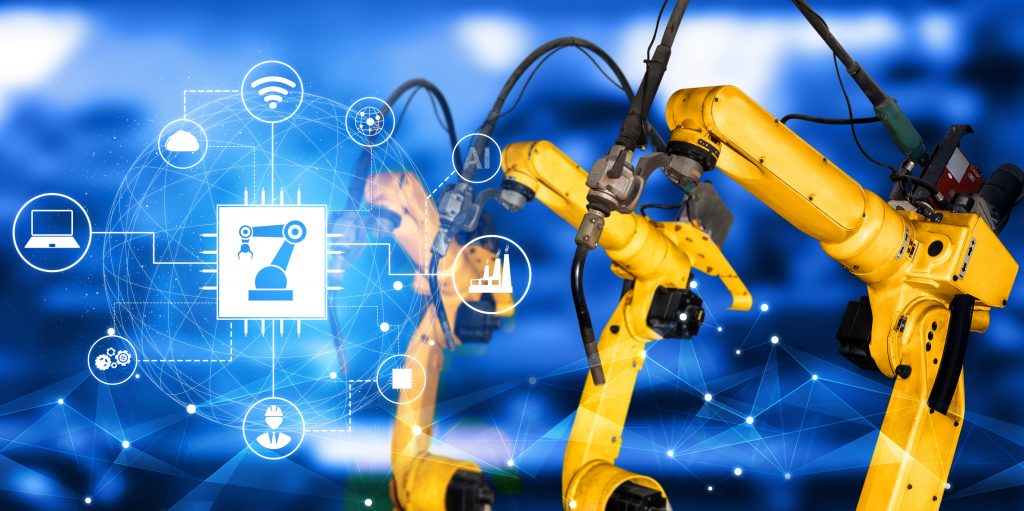IoT Smart Data-Driven Manufacturing
Industrial facilities face an avalanche of data from connected sensing, automation, and facility systems. In most modern industrial applications, this data sits idle or underutilized. The emergence of IoT devices has added to this flow of data. By 2025, there will be 75 billion IoT devices worldwide–over 40 percent of IoT and automation devices in manufacturing industries manage robotic machinery, delivering real-time supply chain analytics and providing equipment diagnostic information among other metrics vital to operational continuity.
Digitized manufacturing has led to industrial facilities with a global distributed footprint–with similar needs required at each location for consistency in operations and quality. To assure operational uptime and performance, deploying on-site staff to manage and monitor these footprints is often not feasible. The unused data turns out to be the answer.
The Enabling Powers of IoT Platforms
Global spending on IIoT Platforms for manufacturing will grow to $12.44B in 2024. Manufacturing is slated to be the largest market for IoT Platforms, with an expected value of $438 million in 2021, with Industry 4.0 spending to increase to $310 billion by 2023.
IoT platforms provide real-time intelligence to maintain manufacturing automation and resiliency in an array of applications across a global footprint. It allows manufacturing facilities of all shapes, sizes, and markets to adapt, predict, and maintain consistency in operations and formulation quality.
While these platforms do not replace existing systems, they allow seamless integration of new and old sensing and automation technology to be harnessed across geographically distributed facilities. Unlike traditional automation technology, IoT platforms are vendor agnostic allowing communication to all systems and devices. This mass data approach allows analysis of real-time and historical data to generate actionable, data-driven decisions to be made instantaneously–fostering predictive maintenance, boosting long-term efficiency, lowering energy consumption, increasing workflow, and aiding continuous commissioning philosophies.
Tapping a unified IoT platform as one source of truth, manufacturing executives can prevent costly downtime, delayed production, and supply chain fulfillment. The International Society of Automation estimates that factories lose anywhere from 5 to 20 percent of their productivity due to downtime. Downtime in the auto industry can cost up to $50,000 per minute or $3 million per hour.
IoT Tech Brewed Craft Beers
The Denver, Colorado-based Crooked Stave Artisan Brewery has a quality-driven focus as a modern artisan brewery of craft beers, thanks to the brewing passion of its trendsetting Brewmaster, Chad Yakobson.
Operating since late 2010, the Crooked Stave artisan beer project “blends science and art through creativity and passion” using Brettanomyces yeasts that are matured in oak, to produce “beers of extraordinary complexity.” The sustainable brewery’s deep community roots extend to working with local farmers and skilled craftsmen, integrating the best of ingredients–mostly grown in Colorado–to offer beers of extraordinary quality.
With such attention to the craft, it was not surprising that Yakobson wanted to advance the science behind brewing that was never studied. Integrating an open-source IoT software monitoring solution allowed Yakobson to “dial in” the technology to aggregate hundreds of data points from brewing to packaging and consistency to quality levels. Yakobson and his team customized the Brewery Automation Solutions to their specific needs to gain critical batch data where needed. Managing tanks and brew process with the dashboard allowed precision control and consistency to the brewing process, while Batch Reports provided real-time temperature and laboratory testing views all on one dynamic screen. Brewers use their own recipes, set temperatures at each stage of the brew and with Brewhouse Controls gain exact monitoring, control and reading in the final batch report–Brewers can program step mashing and remotely turn on their boiler before brewing.
Sharing data across the brewery, compiled onto the IoT platform, allows everyone to view and know what’s going on at different stages of the business. Jordan Fey, Crooked Stave’s Quality Control, can test the pH levels and upload all the information onto the IoT platform to control fermentation levels. “If one of them isn’t going the way we like, we can look and see how we treated or fixed it previously and how we can fix it now,” says Fey.
“Sky is the limit. If you can think it, we can do it. We are making the best beer we’ve ever made–we’re incorporating an IoT platform solution for the future, not just for today,” says Yakobson.
IoT Platforms, unlike traditional industrial automation, allow flexibility and adaptability to change and meet new business challenges. End-users can adapt the analytics to their needs on the fly; change workflows and operational characteristics with no custom programming or third-party consultation. Improving efficiency, asset management and utilization, remote triage of problems and work order management, with IoT platforms’ single-pane-of-glass operational view allows operators real-time and historical context across all distributed facilities and equipment for remote management of all operations, leaving truck rolls as a last resort. Learn the importance of adopting IoT for manufacturing sector.
In the global fast-paced manufacturing industry–with facilities distributed across the country or the globe–transforming data into business intelligence is the gold standard for operational supremacy. And IoT platforms are the cost-effective solution for excellence.
About the Author
 This article was written by Michael C. Skurla, the Chief Product Officer of Radix IoT. Michael has over two decades of experience in control automation and IoT product design with Fortune 500 companies, focusing on the intersection of software and hardware that emphasizes data aggregation and analytics for mission-critical industries.
This article was written by Michael C. Skurla, the Chief Product Officer of Radix IoT. Michael has over two decades of experience in control automation and IoT product design with Fortune 500 companies, focusing on the intersection of software and hardware that emphasizes data aggregation and analytics for mission-critical industries.
